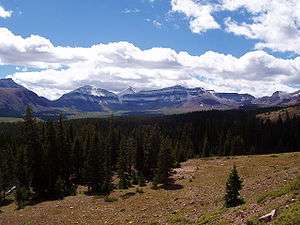Wasatch and Uinta montane forests
The Wasatch and Uinta montane forest is a temperate coniferous forest ecoregion in the Wasatch Range and Uinta Mountains of the western Rocky Mountains system, in the Western United States.
| Wasatch and Uinta montane forests | |
|---|---|
 Coniferous forest with Kings Peak in the background, Uinta Mountains | |
 | |
| Ecology | |
| Realm | Nearctic |
| Biome | Temperate coniferous forest |
| Borders | Colorado Plateau shrublands, Wyoming Basin shrub steppe and Great Basin shrub steppe |
| Bird species | 190[1] |
| Mammal species | 91[1] |
| Geography | |
| Area | 41,500 km2 (16,000 sq mi) |
| Country | United States |
| States | Utah, Wyoming and Idaho |
| Conservation | |
| Habitat loss | 2.45%[1] |
| Protected | 68.9%[1] |
Setting
This ecoregion is located almost entirely within the state of Utah, with a very small portion stretching north into southwestern Wyoming and southeastern Idaho. This ecoregion covers the driest ranges of the Rocky Mountains, in the rain shadow of the Sierra Nevada to the west.
Flora
The dominant vegetation type of this ecoregion is coniferous forest, composed mainly of ponderosa pine (Pinus ponderosa), Rocky Mountain Douglas-fir (Pseudotsuga menziesii subsp. glauca), subalpine fir (Abies lasiocarpa), Engelmann spruce (Picea engelmanni) and trembling aspen (Populus tremuloides), with limited populations of limber pine (Pinus flexilis). This ecoregion is unique from other Rocky Mountain ecoregions in that large areas are dominated by Gambel oak (Quercus gambelii).
Fauna
Mammals include mule deer (Odocoileus hemonius), elk (Cervus canadensis), moose (Alces alces), bighorn sheep (Ovis canadensis), mountain goat (Oreamnos americanus), black bear (Ursus americanus) and cougar (Puma concolor).
Threats and preservation
The majority of this ecoregion has been greatly affected by livestock grazing, logging, mining, and recreational uses such as downhill skiing, and as a result, its conservation status is "critical/endangered". Very few areas are protected, and the largest area that is protected, the High Uintas Wilderness in northeastern Utah, mainly protects areas in the high alpine zone, with the more diverse montane and subalpine zones being almost entirely unprotected. The main threats to this ecoregion's integrity are motorised recreation, widespread livestock grazing and downhill skiing. This region has also been severely effected by mountain pine beetle outbreaks in the last decades, killing large swathes of forest.
References
- Hoekstra, J. M.; Molnar, J. L.; Jennings, M.; Revenga, C.; Spalding, M. D.; Boucher, T. M.; Robertson, J. C.; Heibel, T. J.; Ellison, K. (2010). Molnar, J. L. (ed.). The Atlas of Global Conservation: Changes, Challenges, and Opportunities to Make a Difference. University of California Press. ISBN 978-0-520-26256-0.
- "Wasatch and Uinta montane forests". Terrestrial Ecoregions. World Wildlife Fund.
- Wasatch and Uinta montane forests (National Geographic)
- Wasatch and Uinta montane forests (Vanderbilt University)